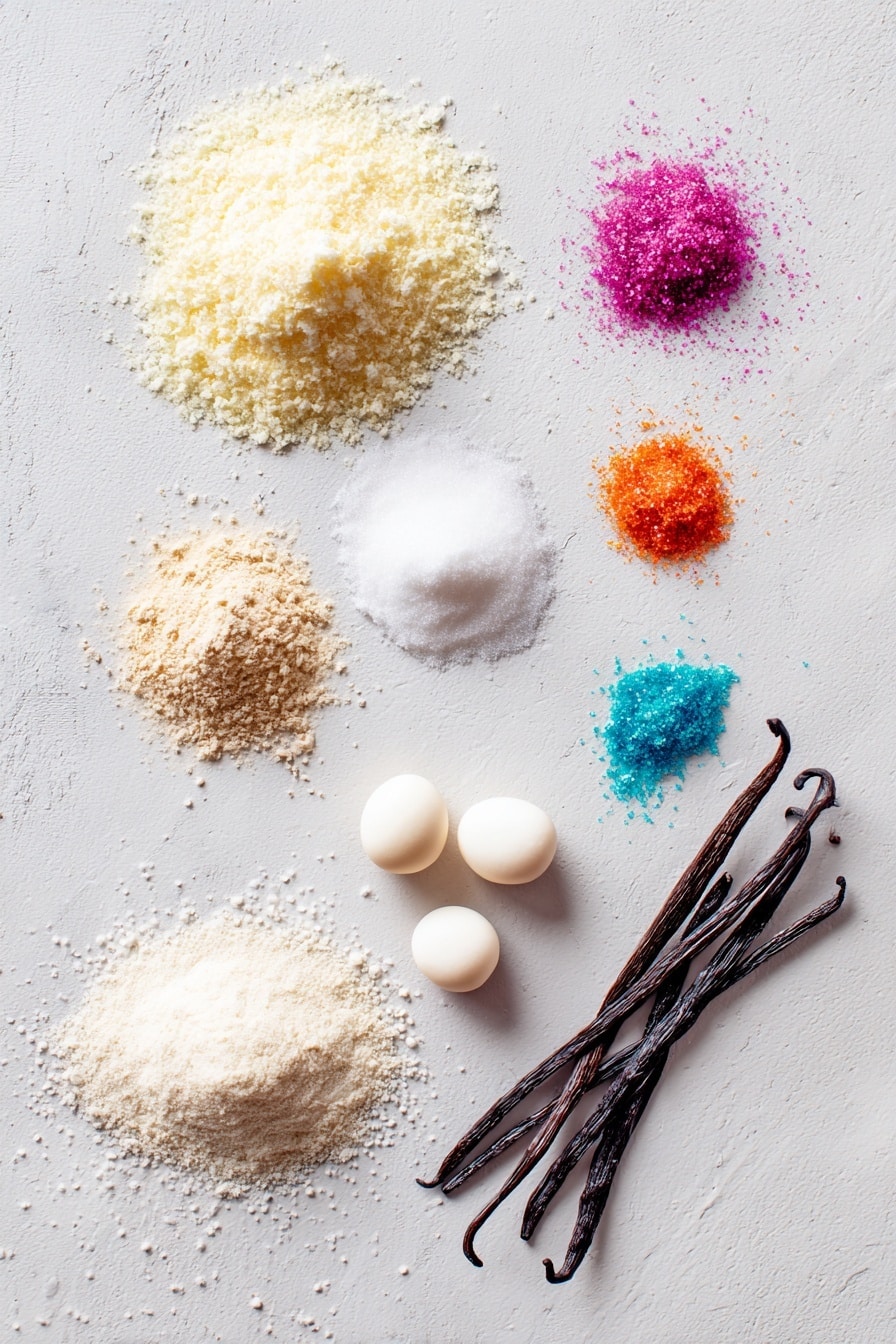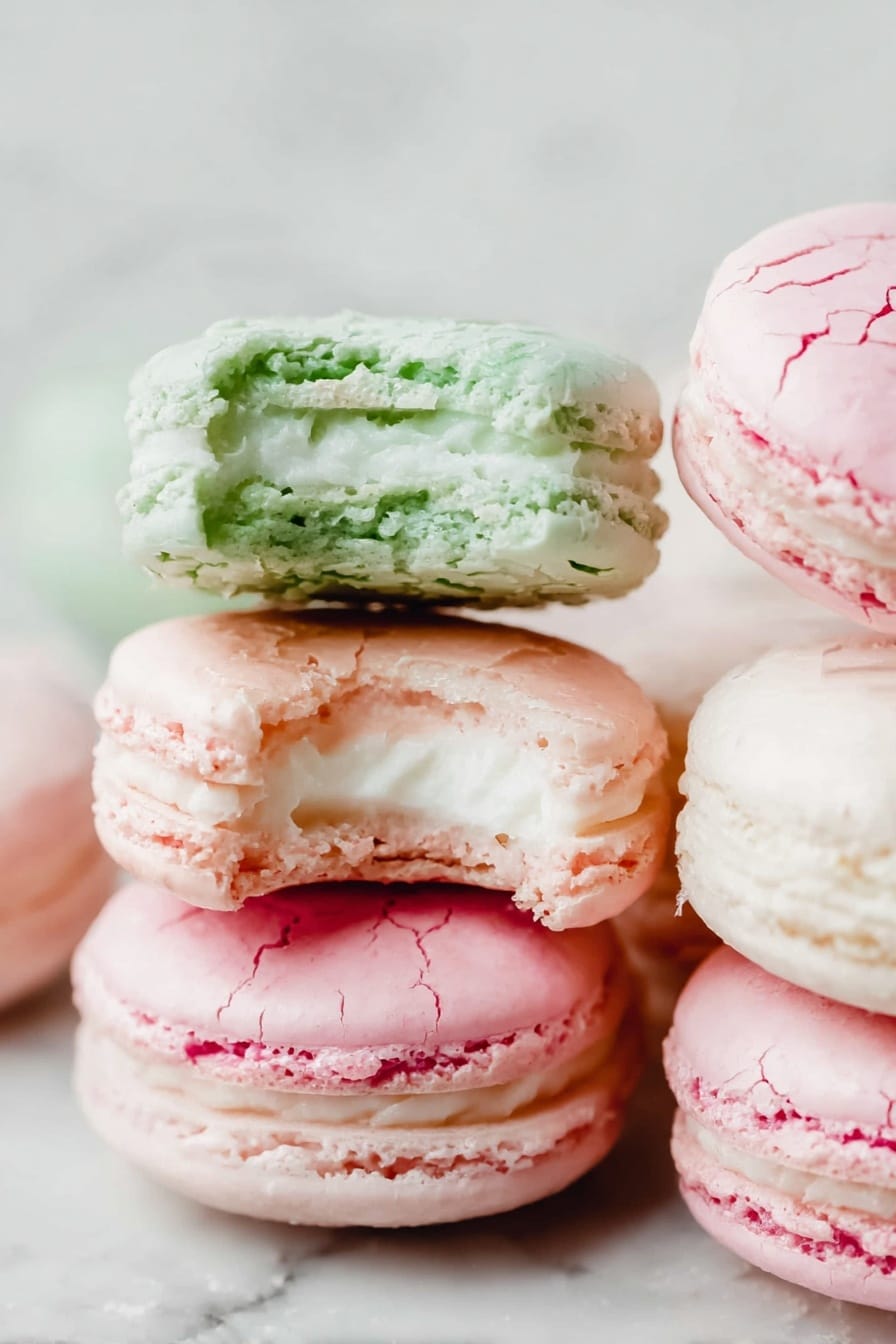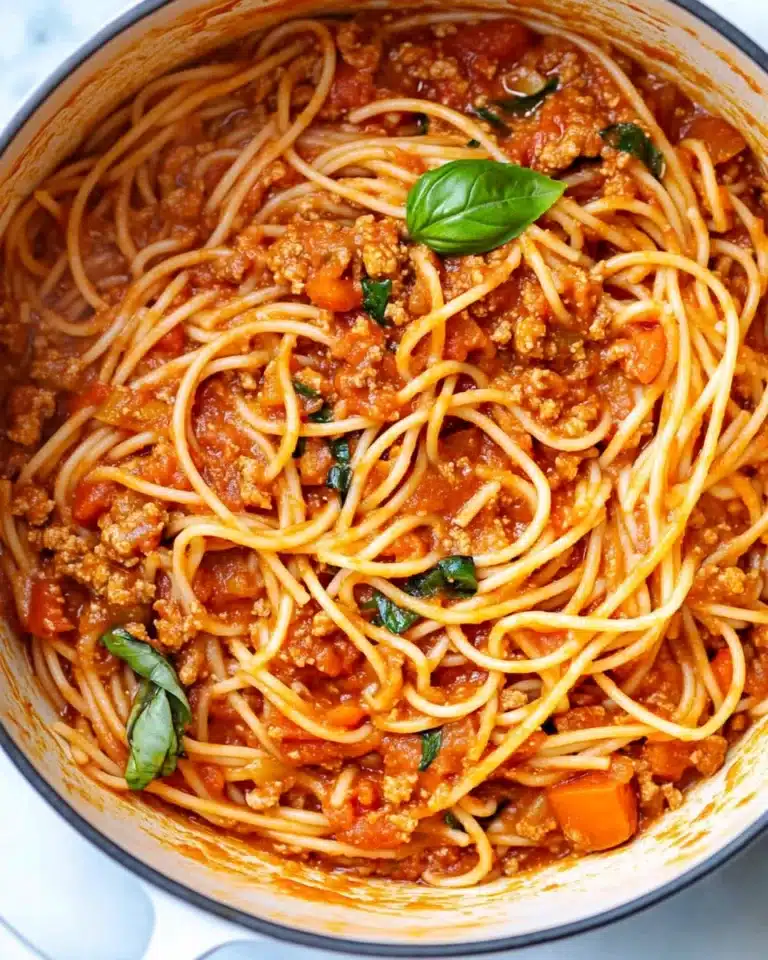
If you’ve ever dreamed of mastering the perfect delicate, melt-in-your-mouth cookie, this French Macarons Recipe is absolutely what you need. I’m talking those beautiful pastel shells with that perfect little ruffled foot and a creamy filling that’s just right. When I first made these, I was so nervous, but this recipe simplified every tricky step—and now I want to share all my tips and secrets with you so you’ll nail these gorgeous treats every time!
Why You’ll Love This Recipe
- Reliable Success: This French Macarons Recipe breaks down every step with clear, tested instructions so you avoid common pitfalls.
- Beautiful Results: You’ll get perfectly smooth shells with ruffled “feet” that look like they belong in a French patisserie.
- Customizable Flavors: You can easily swap extracts and fillings to match your mood—or wow guests at your next party.
- Great for Various Skill Levels: Whether you’re a first-timer or looking to perfect your macarons, I’ve got you covered.
Ingredients You’ll Need
These ingredients come together to give you that delicate crisp shell with a tender, chewy inside—the hallmark of a perfect French macaron. Make sure to use superfine sugar and almond flour that’s as fine as possible for the best texture.

- Egg Whites: Using aged egg whites (refrigerated for 24 hours) helps create a stable meringue with more volume; gently bring them to room temp before beating.
- Cream of Tartar: This little acid stabilizes the egg whites to keep your meringue nice and fluffy without collapsing.
- Extract (Vanilla, Almond, Coconut, etc.): Optional but adds a subtle flavor boost; feel free to get creative here.
- Superfine Sugar (Caster Sugar): This dissolves quickly into the egg whites, preventing grainy texture—you won’t want to substitute regular granulated sugar here.
- Gel Food Coloring: Adds vibrant color without altering batter consistency—powders or liquids can mess with texture.
- Almond Flour: Be sure it’s finely ground and sifted; coarse almond flour can ruin your shells’ smoothness.
- Confectioners’ Sugar (Powdered Sugar): Helps achieve that classic glossy, smooth finish on your shells.
- Macaron Filling: Pick your favorite—ganache, buttercream, jam—your filling choice makes these uniquely yours.
Variations
I love experimenting with flavors and colors with macarons because that’s part of the fun! You can easily tailor this French Macarons Recipe to suit your taste or dietary needs—plus, swapping fillings can transform the cookie for any season or celebration.
- Flavor Twists: Try pistachio extract or lemon zest in the shells—my family goes crazy for the combo of classic vanilla shells with a zesty lemon buttercream filling.
- Color Play: Pastel gel colors make them look festive—perfect for birthdays or holidays. I’ve used soft lavender and mint green with great success.
- Diet-Friendly: For gluten-free baking, this recipe is naturally safe, just verify your almond flour and sugar. Vegan versions are a challenge, but experimenting with aquafaba might be fun if you’re adventurous!
- Filling Variety: Chocolate ganache, raspberry jam, salted caramel, or cream cheese frosting—each option changes the vibe completely. I prefer piping ganache for neat, uniform cookies.
How to Make French Macarons Recipe
Step 1: Age Your Egg Whites for Best Meringue
This trick took me by surprise at first—I discovered that aging your egg whites by leaving them covered in the fridge for 24 hours (wipe the bowl with lemon juice or vinegar first!) helps produce that sturdy but airy meringue you need. When you bring them out, be sure they’re at room temperature before you start beating. Cold egg whites just won’t whip as well.
Step 2: Whip the Egg Whites into Soft, then Stiff Peaks
Add cream of tartar and your extract, then start whipping at medium speed. At first, your whites will look foamy, and that’s totally normal. Keep going until you see soft peaks—when the beaters leave tracks but the peaks gently hold their shape. Then slowly add superfine sugar in thirds, beating in between, until you get stiff, glossy peaks that don’t move when you tip the bowl. This took me a couple of tries to perfect because under or overbeating can affect the final texture.
Step 3: Sift and Fold Your Dry Ingredients
Combine the almond flour and confectioners’ sugar by sifting them together seriously well—no big lumps allowed! I usually work the larger bits through the sieve with a spoon so I don’t lose precious almond flour. Then, gently fold your stiff egg whites into this dry mix in thirds, being careful not to deflate the meringue too much. The goal is a smooth, lava-like batter that slowly drips from your spatula. The “figure 8” test is a game changer here; it’s how you’ll know when you’ve folded just right.
Step 4: Pipe and Rest Your Macaron Shells
Fill a piping bag with your batter and pipe consistent rounds about 1.5 to 2 inches wide on silicone mats or parchment paper-lined trays. Bang your trays gently on the counter to pop any air bubbles, and if you spot stubborn ones, use a toothpick to carefully pop them. This part really improved my shells’ smoothness. Then the magic: let those piped shells sit at room temperature for at least 30 minutes until they’re dry to the touch—this “skin” helps create those signature feet during baking.
Step 5: Bake and Cool Perfectly
Preheat your oven to 325°F (163°C). Bake the shells for about 13 minutes until they don’t wobble when you gently touch the top (using a spoon or finger carefully, they will be hot!). I usually watch closely near the end and add a couple more minutes if they still seem soft. Let them cool completely on the baking sheet before gently transferring to a wire rack. I learned the hard way not to try removing them too soon or they stick and break—patience here is key.
Step 6: Fill and Enjoy (or Refrigerate for Maturing)
Once cooled, sandwich your macarons with your chosen filling. I prefer piping the filling for a neat finish, but spreading with a knife works great too. If you can, refrigerate them overnight to let the flavors meld—it makes a noticeable difference, trust me! Just bring them to room temperature before serving so they’re soft and chewy the way macarons should be.
Pro Tips for Making French Macarons Recipe
- Aging Egg Whites: I learned aging egg whites for 24 hours really boosts volume and sturdiness of your meringue—don’t skip this step.
- Figure 8 Test: This is my favorite way to judge batter consistency; folding slowly to “just right” is crucial to avoid thin or dense macarons.
- Popping Air Bubbles: Tapping the pans and poking bubbles with a toothpick saves your shells from cracks or big holes.
- Cooling Patience: Resist moving shells too early! Waiting 15 minutes or more on the baking sheet prevents breaking fragile bottoms.
How to Serve French Macarons Recipe

Garnishes
I usually keep garnishes simple—a light dusting of powdered sugar or edible glitter adds just the right touch of elegance. For festive occasions, a tiny fresh flower or a swirl of colored buttercream on top makes them pop visually. My kids loved when I added sprinkles around the edges for parties!
Side Dishes
Of course, macarons are a dessert on their own, but I like pairing them with a nice cup of tea or espresso to balance their sweetness. Fresh berries or a small bowl of creamy whipped mascarpone also complement these little treats beautifully if you want to serve something extra.
Creative Ways to Present
For birthdays or bridal showers, I’ve arranged macarons in towers or colorful rows inside clear boxes tied with pretty ribbons. You could even use them as edible party favors! Sometimes I place them on mini cake stands with flowers for a stunning display.
Make Ahead and Storage
Storing Leftovers
After filling, I like to store leftover macarons in an airtight container in the refrigerator—they keep beautifully for up to 5 days. Just bring them back to room temperature before enjoying to get that soft, chewy texture.
Freezing
If you want to keep macarons longer, freezing works surprisingly well! Place them in a single layer in an airtight container, separating layers with parchment. When ready to eat, thaw them in the fridge for a few hours, then bring to room temp. The texture and flavor hold up nicely.
Reheating
I usually don’t reheat macarons beyond thawing, but if you like, a quick 5-10 second blast in a microwave (covered) can help soften fillings a bit before serving. Just be very careful—microwaves can overheat and ruin the shell texture quickly.
FAQs
-
What does “feet” mean in macarons?
The “feet” are the ruffled, frilly edges at the base of each macaron shell that form during baking. They indicate that the macarons have risen properly and are a hallmark of a successful bake.
-
Can I make macarons without a kitchen scale?
While it’s best to use a kitchen scale for accuracy and consistent results, you can convert measurements to cups and teaspoons. Just be aware that small deviations can greatly affect your macarons’ texture and appearance.
-
Why are my macarons cracking?
Common reasons include insufficient drying time before baking, an oven that’s too hot, or overmixing the batter. Make sure to let your shells develop a dry skin for 30-60 minutes, check oven temperature with a thermometer, and fold carefully to the right consistency.
-
How do I know when my meringue peaks are stiff enough?
Stiff peaks stand straight up and don’t droop when you lift the whisk. You can even invert the bowl gently without the meringue sliding out. The surface should look glossy and smooth.
Final Thoughts
This French Macarons Recipe is truly a joy to make once you get the hang of the process, and I absolutely love how elegant and impressive these cookies look on any dessert table. I remember feeling so proud the first time my macarons came out perfectly—I know you’ll have that moment too! So grab your ingredients, take a deep breath, and have fun crafting these delicate beauties. Trust me, your friends and family will be begging for more.
Print
French Macarons Recipe
- Prep Time: 1 hr
- Cook Time: 13 min
- Total Time: 1 hr 30 min
- Yield: 40 shells; about 20 sandwiched macarons
- Category: Dessert
- Method: Baking
- Cuisine: French
- Diet: Vegetarian
Description
Classic French macarons are delicate, crisp on the outside, and chewy on the inside almond meringue cookies. This recipe guides you through the process of creating the perfect macaron shells, including steps for beating egg whites, folding the batter with almond flour and confectioners’ sugar, piping, resting, and baking to achieve the signature feet and texture. Customize your macarons with various fillings for a sophisticated, elegant treat.
Ingredients
Macaron Shells
- 100g egg whites (approximately 3–4 large egg whites)
- 1/4 teaspoon (1g) cream of tartar
- 1/2 teaspoon extract (vanilla, almond, coconut, optional)
- 80g superfine sugar (caster sugar)
- 1–2 drops gel food coloring (optional)
- 125g almond flour
- 125g confectioners’ sugar
Filling
- Desired macaron filling (buttercream, ganache, jam, lemon curd, or other fillings)
Instructions
- Prepare Egg Whites: Wipe a large glass or metal mixing bowl with lemon juice or vinegar. Add egg whites, cover, and refrigerate for 24 hours. Bring to room temperature before using.
- Prepare Baking Sheets: Line three large baking sheets with silicone baking mats or parchment paper and set aside.
- Beat Egg Whites: Add cream of tartar and extract (if using) to egg whites. Using a hand or stand mixer with a whisk attachment, beat on medium speed until soft peaks form. Gradually add superfine sugar in three increments while continuing to beat, finishing on medium-high speed to achieve stiff, glossy peaks that hold shape firmly.
- Add Food Coloring: Gently fold 1-2 drops of gel food coloring into the egg whites with a rubber spatula if desired.
- Sift Dry Ingredients: Sift almond flour and confectioners’ sugar together into a large bowl, breaking up any clumps with a spoon to retain as much flour as possible.
- Combine Batter: Fold the beaten egg whites into the almond flour mixture in three additions. Carefully fold to achieve a batter consistency like honey using the ‘figure 8’ test—batter should flow slowly and sink back within 10 seconds without being too runny or too stiff.
- Pipe Macarons: Transfer batter to a piping bag fitted with a medium round tip. Pipe 1.5–2 inch rounds spaced 1-2 inches apart on prepared baking sheets. Tap pans on the counter to release air bubbles, then pop remaining bubbles with a toothpick.
- Rest Macarons: Allow piped shells to sit at room temperature 30-60 minutes until a dry, non-tacky skin forms to help develop the characteristic feet during baking. Avoid resting too long to prevent deflation.
- Preheat Oven: Preheat oven to 325°F (163°C).
- Bake Macarons: Bake for 13 minutes. Check doneness by gently touching a shell; if wobbly, bake 1-2 minutes longer. Macarons are done when tops are set and shells don’t move when touched.
- Cool Shells: Let macarons cool on baking sheets for 15 minutes before transferring to a wire rack to cool completely. This prevents sticking and breaking.
- Fill and Assemble: Once cooled, pair shells of similar size and fill with your choice of filling using a knife or piping bag. Sandwich the shells together gently.
- Mature (Optional): For best flavor and texture, refrigerate assembled macarons covered for 12-24 hours before serving. Bring to room temperature before eating.
- Storage: Store leftover macarons in an airtight container in the refrigerator for up to 5 days.
Notes
- Use precise gram measurements for best results; a kitchen scale is recommended.
- Superfine (caster) sugar dissolves more easily for a smooth meringue; you may pulse regular granulated sugar in a food processor if needed.
- Resting baked macarons in the fridge allows the flavors to mature and the texture to improve, but you can enjoy them right away.
- Try various fillings such as chocolate ganache, raspberry jam, lemon curd, or buttercream to customize your macarons.
- Be careful not to overmix or undermix the batter; the figure 8 test is key to achieving the right consistency.
- Ensure the mixing bowl is spotless and free of grease to achieve proper meringue peaks.
Nutrition
- Serving Size: 1 sandwich macaron (approx. 15g)
- Calories: 75
- Sugar: 12g
- Sodium: 5mg
- Fat: 3.5g
- Saturated Fat: 0.3g
- Unsaturated Fat: 3g
- Trans Fat: 0g
- Carbohydrates: 10g
- Fiber: 0.5g
- Protein: 2g
- Cholesterol: 0mg








